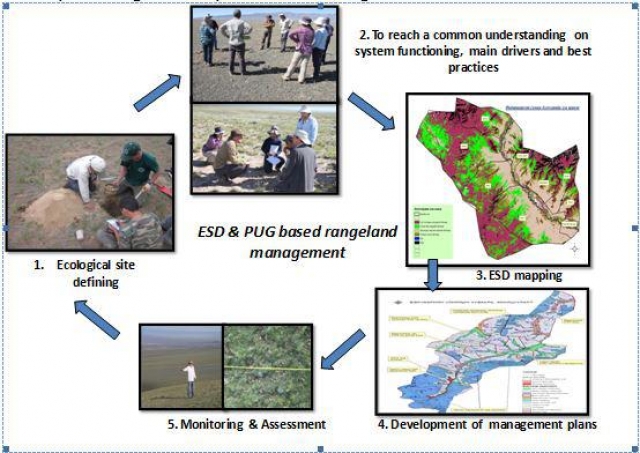ID :
315659
Wed, 01/29/2014 - 14:21
Auther :
Shortlink :
https://oananews.org//node/315659
The shortlink copeid
"GREEN GOLD" HELPS HERDERS DEVELOP BETTER LAND MANAGEMENT PLANS

Ulaanbaatar /MONTSAME/ Information and mapping about rangeland potential developed through Ecological Site Description (ESD) studies is helping herders and local authorities to draft sustainable rangeland-management plans, reported Swiss Agency for Development and Cooperation website on Monday.
To assist with the practical application of the ESD, SDC’s Green Gold Project, in conjunction with the Agency for Land Affairs, Geodesy and Cartography (ALAGAC) and the Mongolian State University of Agriculture, organised a demonstration workshop on integrating the ESD concept into user-based rangeland-management plans in October 2013 in Undurshireet soum, Tuv aimag.
Undurshireet soum was selected as being representative of the dry steppe region, as well as for having a low potential for productivity and reversibility and an excessive livestock population. Eight Pasture-User Groups (PUGs) have been established in the soum to coordinate and regulate local herders’ shared access to common seasonal rangelands, with support from Green Gold.
The ESD concept is based on factual ground data and knowledge that defines a site’s ecological potential and promotes an understanding of how its ecosystems function, as well as its main drivers and the most suitable land-management practices.
As the following illustration demonstrates, the ESD concept is now a key tool for rangeland-management planning and impact monitoring.
The Green Gold-supported study undertaken by the ALAGAC’s ESD team found that rangeland in Undurshireet soum could be classified into four main ecological sites based on different levels of grazing pressure and potential for recovery. The study’s findings are now being used by local herders and authorities to develop the soum’s 2014 land-management pilot plan, which has been approved by the local Citizens’ Representatives Khural.
More than 60 representatives of policymaking bodies (the Land Reform Committee, ALAGAC, and neighbouring soum governments), research institutes (professors and researchers in natural-resource management), the local community (herders and PUG leaders) and funding agencies (UNDP, the Oyu Tolgoi mining company) took part in the workshop.
Undurshireet soum governor Mr. Lkhamsuren highlighted the importance of the workshop: “Due to the drastic changes of the past decades in herd numbers and composition, the impact of overgrazing is becoming more severe, and we need a clear recommendation or tool for proper management. This is a great opportunity that our soum is selected as a pilot soum, and I am encouraging my colleagues to collaborate with the ESD team to make meaningful progress in rangeland and herd management.”
Mr. Dorjgochoo, a herder representative and “Tesegt” PUG leader, said of the workshop: “I like this participatory approach for planning because being together with decision-makers and herders from neighbouring PUGs enables us to find a solution for our summer pasture-resting. Next year in the beginning of the growing season, our PUG herders will move to the Berkh PUG area and rest our summer pasture.”
One of the key messages to come out of the workshop was that the local herders and PUGs are key players in rangeland management processes, such as planning, implementation and monitoring.





